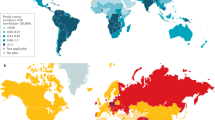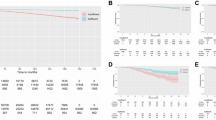Abstract
Squamous cell carcinoma (SCC) of the penis is an uncommon disease in the US and Europe. Without treatment, patients with penile SCC usually die within 2 years after diagnosis of the primary lesion, because of uncontrollable locoregional disease or from distant metastases. The spread of the tumor to the locoregional lymph nodes (lymph-node positivity) is the most relevant prognostic factor. With the available treatments, 5-year cancer-specific survival probabilities are between 75% and 93% for those patients with clinically node-negative disease, and progressively lower for those with increasingly extensive node-positive disease. Similarly, patients with pathologically proven negative nodes have 5-year cancer-specific survival probabilities ranging from 85% to 100%. While patients with a single positive superficial lymph node on pathology have very good cancer-related outcomes, patients with multiple involved lymph nodes have significantly less favorable outcomes. This article focuses on the most important issues that surround the prognosis of squamous cell carcinoma of the penis, with special attention to the prognostic nomograms for penile cancer patients published in 2006.
Key Points
-
Squamous cell carcinoma (SCC) of the penis is an uncommon malignant disease, which substantially limits the value of epidemiologic studies and comprehension of risk factors
-
Without treatment, patients with penile SCC usually die within 2 years after diagnosis of the primary lesion, because of complications due to uncontrollable locoregional growth or from distant metastases
-
The main clinical and pathologic prognostic variables are lymph node stage, venous embolization, and lymphatic embolization
-
Prognostic nomograms that incorporate pathologic variables have been developed, which might be useful for patient counseling and planning of treatment with regard to early inguinal lymphadenectomy and (when available) adjuvant therapies; however, the external validation of these nomograms is ongoing
-
A few studies indicate a possible prognostic role for molecular markers, such as expression of tumor-suppressor genes, adhesion molecules and metalloproteinases, but further research is needed in this field
-
The research performed on SCC in other areas of the body (such as the head and neck) as well as multi-institutional collaborations that pool the number of cases of penile SCC will be useful to increase the available knowledge on penile SCC
This is a preview of subscription content, access via your institution
Access options
Subscribe to this journal
Receive 12 print issues and online access
$209.00 per year
only $17.42 per issue
Buy this article
- Purchase on Springer Link
- Instant access to full article PDF
Prices may be subject to local taxes which are calculated during checkout



Similar content being viewed by others
References
Mobilio G et al. (2001) Genital treatment of penile carcinoma. Curr Opin Urol 11: 299–304
Jemal A et al. (2006) Cancer statistics, 2006. CA Cancer J Clin 56: 106–130
Misra S et al. (2004) Penile carcinoma: a challenge for the developing world. Lancet Oncol 5: 240–247
Busby JE et al. (2005) What's new in the management of penile cancer? Curr Opin Urol 15: 350–357
Lont AP et al. (2006) Presence of high-risk human papillomavirus DNA in penile carcinoma predicts favorable outcome in survival. Int J Cancer 119: 1078–1081
Kroon BK et al. (2005) Contemporary management of penile squamous cell carcinoma. J Surg Oncol 89: 43–50
Fraley EE et al. (1989) The role of ilioinguinal lymphadenectomy and significance of histological differentiation in treatment of carcinoma of the penis. J Urol 142: 1478–1482
McDougal WS (1995) Carcinoma of the penis: improved survival by early regional lymphadenectomy based on the histological grade and depth of invasion of the primary lesion. J Urol 154: 1364–1366
Lopes A et al. (1996) Prognostic factors in carcinoma of the penis: multivariate analysis of 145 patients treated with amputation and lymphadenectomy. J Urol 156: 1637–1642
Slaton JW et al. (2001) Tumor stage, vascular invasion and the percentage of poorly differentiated cancer: independent prognosticators for inguinal lymph node metastasis in penile squamous cancer. J Urol 165: 1138–1142
Solsona E et al. (1992) Corpus cavernosum invasion and tumor grade in the prediction of lymph node condition in penile carcinoma. Eur Urol 22: 115–118
Solsona E et al. (2001) Prospective validation of the association of local tumor stage and grade as a predictive factor for occult lymph node micrometastasis in patients with penile carcinoma and clinically negative inguinal lymph nodes. J Urol 165: 1506–1509
Solsona E et al. (2004) EAU guidelines on penile cancer. Eur Urol 46: 1–8
Ficarra V et al. (2005) Lymphatic and vascular embolizations are independent predictive variables of inguinal lymph node involvement in patients with squamous cell carcinoma of the penis. Cancer 103: 2507–2516
Ficarra V et al. (2006) Nomogram predictive of pathological inguinal lymph node involvement in patients with squamous cell carcinoma of the penis. J Urol 175: 1700–1705
Horenblas S et al. (1993) Squamous cell carcinoma of the penis. III. Treatment of regional lymph nodes. J Urol 149: 492–497
Horenblas S et al. (1994) Squamous cell carcinoma of the penis. IV. Prognostic factors of survival: analysis of tumor, nodes and metastasis classification system. J Urol 151: 1239–1243
Bezerra ALR et al. (2001) Human papillomavirus as a prognostic factor in carcinoma of the penis analysis of 82 patients treated with amputation and bilateral lymphadenectomy. Cancer 91: 2315–2321
Kattan MW et al. (2006) Nomogram predictive of cancer specific survival in patients undergoing partial or total amputation for squamous cell carcinoma of the penis. J Urol 175: 2103–2108
Villavicencio H et al. (1997) Grade, local stage and growth pattern as prognostic factors in carcinoma of the penis. Eur Urol 32: 442–447
Lopes A et al. (2002) p53 as a new prognostic factor for lymph node metastasis in penile carcinoma: analysis of 82 patients treated with amputation and bilateral lymphadenectomy. J Urol 168: 81–86
Campos RS et al. (2006) E-cadherin, MMP-2, and MMP-9 as prognostic markers in penile cancer: analysis of 125 patients. Urology 67: 797–802
Kamat MR et al. (1993). Carcinoma of the penis: the Indian experience. J Surg Oncol 52: 50–55
Kulkarni JN et al. (1994) Prophylactic bilateral groin node dissection versus prophylactic radiotherapy and surveillance in patients with N0 and N1 ± 2 carcinoma of the penis. Eur Urol 26: 123–128
Srinivas V et al. (1987) Penile cancer: relation of extent of nodal metastasis to survival. J Urol 137: 880–882
Ornellas AA et al. (1991) Analyses of 200 lymphadenectomies in patients with penile carcinoma. J Urol 146: 330–332
Ravi R (1993) Morbidity following groin dissection for penile carcinoma. Br J Urol 72: 941–945
Brkovic D et al. (1997) Surgical treatment of invasive penile cancer—the Heidelberg experience from 1968 to 1994. Eur Urol 31: 339–342
Author information
Authors and Affiliations
Corresponding author
Ethics declarations
Competing interests
The authors declare no competing financial interests.
Rights and permissions
About this article
Cite this article
Novara, G., Galfano, A., De Marco, V. et al. Prognostic factors in squamous cell carcinoma of the penis. Nat Rev Urol 4, 140–146 (2007). https://doi.org/10.1038/ncpuro0751
Received:
Accepted:
Issue Date:
DOI: https://doi.org/10.1038/ncpuro0751
This article is cited by
-
Competing-risks analysis for evaluating the prognosis of patients with microinvasive cutaneous squamous cell carcinoma based on the SEER database
BMC Medical Research Methodology (2023)
-
Comparison of two hybrid sentinel node tracers: indocyanine green (ICG)-99mTc-nanocolloid vs. ICG-99mTc-nanoscan from a nuclear medicine and surgical perspective
European Journal of Nuclear Medicine and Molecular Imaging (2023)
-
Penile cancer
Nature Reviews Disease Primers (2021)
-
The prognostic significance of primary tumor size in squamous cell carcinoma of the penis
Discover Oncology (2021)
-
Comparative study of perioperative and survival outcomes after video endoscopic inguinal lymphadenectomy (VEIL) and open inguinal lymph node dissection (O-ILND) in the management of inguinal lymph nodes in carcinoma of the penis
Journal of Robotic Surgery (2021)



